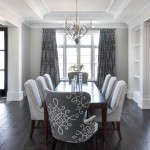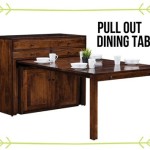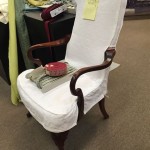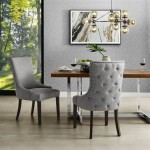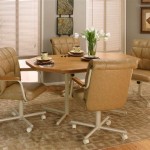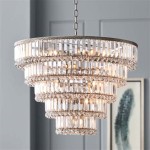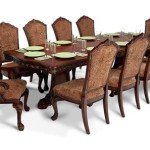Elevating Your Dining Experience: Dining Room Table Setting Ideas
A dining room table setting is more than just arranging plates and cutlery. It's an opportunity to create an atmosphere, reflect personal style, and enhance the overall dining experience for guests. A well-set table can transform an ordinary meal into a memorable occasion, regardless of whether it's a formal dinner party or a casual family gathering. The specifics of the setting will depend on the occasion, the menu, and the desired aesthetic, but understanding the fundamentals is crucial for creating a visually appealing and functional tablescape.
The principles of table setting are rooted in etiquette and practicality. Correct placement of each element ensures ease of use and avoids confusion during the meal. Furthermore, a thoughtfully arranged table demonstrates attention to detail and consideration for the comfort of those dining. Ignoring these details can detract from the overall experience and even create an impression of carelessness.
Formal Table Settings: A Step-by-Step Guide
A formal table setting is typically reserved for special occasions, such as holidays, weddings, or upscale dinner parties. It involves a greater number of elements and a more precise arrangement than a casual setting. While the specifics may vary based on the number of courses, the following guidelines offer a general framework for creating a sophisticated and elegant formal table:
The foundation of a formal table setting is the charger plate or service plate. This large, decorative plate sits beneath the dinner plate and remains on the table throughout the appetizer and salad courses. It's removed before the main course is served. Place the charger plate centered in front of the chair.
Next, the dinner plate is placed directly on top of the charger plate. The salad plate is then placed on top of the dinner plate. If a soup course is planned, the soup bowl rests on top of the salad plate. If no charger plate is used, the dinner plate is the first plate in the stack.
Cutlery placement follows a specific order, working from the outside in, based on the order in which the courses will be served. Forks are placed to the left of the plate, with the salad fork furthest to the left, followed by the dinner fork. If a fish course is included, the fish fork is placed to the left of the dinner fork. Spoons are placed to the right of the plate, with the soup spoon furthest to the right, followed by the teaspoon. Knives are placed to the right of the plate, with the blade facing the plate. If a butter knife is needed, it is placed horizontally on the bread plate, typically located above the forks, with the blade facing inwards.
Glasses are placed above the knives, typically in order of size from left to right. The water glass is placed closest to the knives, followed by the wine glasses. The number of wine glasses will depend on the wines being served with the meal. A champagne flute may also be included if appropriate. Generally, the glasses align with the knives and spoons for a visually consistent setup.
Linens play a crucial role in a formal table setting. A tablecloth is typically used to cover the entire table, providing a clean and elegant backdrop. Napkins are placed either to the left of the forks, underneath the forks, or on the dinner plate. Linen napkins are preferred for formal occasions, and they can be folded into decorative shapes to add visual interest.
Finally, decorative elements can be added to enhance the overall aesthetic. Centerpieces, such as floral arrangements, candles, or sculptural objects, can add height and visual appeal. Place cards are used to indicate seating arrangements and can be personalized to add a thoughtful touch. The centerpiece should not obstruct the view of guests across the table and should complement the overall theme of the event. Candles should be unscented to avoid interfering with the aroma of the food.
Casual Table Settings: Practicality and Style
Casual table settings are designed for everyday meals and informal gatherings. They are less elaborate than formal settings but still offer an opportunity to create a welcoming and inviting atmosphere. The focus is on practicality and ease of use, while still maintaining a sense of style.
A placemat or bare table is a practical choice for a casual setting. Placemats offer protection for the table surface and add a touch of color and texture. If using a bare table, consider using coasters to protect against water rings.
The dinner plate is the central element of a casual table setting. It is placed in the center of the placemat or at each person's place setting on the bare table. If a salad is being served as a separate course, the salad plate is placed on top of the dinner plate. If the salad is served on the same plate as the main course, the salad plate is omitted.
Cutlery placement is simplified in a casual setting. A fork is placed to the left of the plate, and a knife and spoon are placed to the right. The knife blade faces the plate. If a soup course is included, a soup spoon is placed to the right of the knife. A teaspoon is placed above the knife, if required, for coffee or tea.
A single glass is typically used for water or another beverage. It is placed above the knife. If wine is being served, a wine glass can be added to the right of the water glass. The placement should be practical and avoid overcrowding the table.
Napkins can be placed to the left of the fork, on the plate, or in a napkin ring. Cloth napkins are a more sustainable option than paper napkins, but paper napkins are perfectly acceptable for a casual setting. Consider using a napkin ring to add a touch of style.
Decorative elements can be used sparingly in a casual setting. A small vase of flowers, a bowl of fruit, or a decorative candle can add a touch of visual interest without overwhelming the table. The focus should be on creating a relaxed and inviting atmosphere.
Thematic Table Settings: Expressing Personal Style
Beyond formal and casual settings, thematic table settings offer an opportunity to express personal style and create a unique dining experience. These settings are often inspired by a particular season, holiday, or cultural theme. The key is to create a cohesive and visually appealing arrangement that reflects the chosen theme.
Seasonal themes are popular for table settings. For example, a spring-themed table might feature pastel colors, floral patterns, and natural elements such as branches and leaves. A fall-themed table might incorporate warm colors, rustic textures, and elements such as pumpkins, gourds, and dried leaves. The colors, textures, and decorative elements should all work together to evoke the feeling of the season.
Holiday themes offer another opportunity for creative table setting. A Christmas-themed table might feature red and green colors, festive decorations such as ornaments and garlands, and traditional tableware. A Thanksgiving-themed table might incorporate autumnal colors, harvest-inspired decorations, and rustic tableware. The key is to create a festive and celebratory atmosphere.
Cultural themes can also inspire distinctive table settings. A table setting inspired by a particular country or region might feature traditional colors, patterns, and tableware. For example, a Mexican-themed table might incorporate bright colors, patterned tablecloths, and traditional pottery. A Japanese-themed table might feature minimalist designs, natural materials, and traditional Japanese tableware. Researching the cultural elements associated with the chosen theme is crucial for creating an authentic and respectful representation.
Color palettes play a significant role in thematic table settings. Choosing a cohesive color palette is essential for creating a visually appealing arrangement. Consider using a main color and accent colors to create depth and interest. For example, a blue and white color palette can create a calming and elegant atmosphere, while a red and gold color palette can create a festive and luxurious atmosphere.
Decorative elements are crucial for expressing the chosen theme. Use decorative elements that complement the overall aesthetic and reinforce the theme. This could include floral arrangements, candles, figurines, or other decorative objects. Scale and proportion are important considerations when choosing decorative elements. Ensure that the elements are appropriately sized for the table and do not obstruct the view of guests.
Ultimately, the best dining room table setting is one that reflects personal style and enhances the dining experience. Experimenting with different styles, colors, and decorative elements can lead to unique and memorable table settings that will impress guests and create lasting memories.

Cozy Christmas Dining Room Decorating Ideas Sanctuary Home Decor

Dining Room Table Decor Ideas How To Decorate Your Hgtv

Spring Dining Room Decor Tour 2024 Thrifty And Chic

3 Simple Table Setting Ideas Pops Of Color Home

Ideas For Setting A Neutral Fall Table Sanctuary Home Decor

80 Best Dining Room Ideas And Decorating Tips

Easy Table Setting Ideas For An Elegant Dining Room Decor Decorative Blog Post Decorating Centre Online

29 Summer Table Décor Ideas To Bring In The Sunshine

Winter White Dining Room Centerpiece Table Centerpieces Decor

5 Table Setting Ideas For Everyday Use Doğtaş

